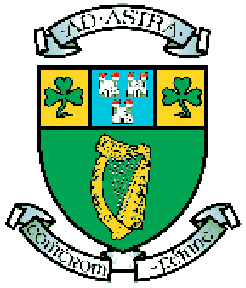
[A0094]

Studies Towards New Reagents for Asymmetric Hydroboration: Synthesis of Racemic Trans-2,5-diisopropylborolane
Kevin J. Hodgetts,* Gerhard Lascober and Massimo Zorzi
Department of Chemistry, University College Dublin, Belfield, Dublin 4, Ireland
Current Address for Correspondence:
K.J. Hodgetts, Neurogen Corporation, 35 Northeast Industrial Road,
Branford, CT 06405, USA.
E-mail:
[email protected]
Received: 17 August 2000 / Uploaded: 20 August
Abstract
The cyclic hydroboration of 2,7-dimethyl-2,6-octadiene was studied. It was found that the stereochemical outcome of the reaction was dependent upon the solvent, temperature, time, and the nature of the borane reagent. Monobromoborane in carbon tetrachloride at 76 oC gave after 8 hr a 4:1 mixture of trans:cis-2,5-diisopropylborolane. Pure racemic trans-2,5-diisopropyl borolane was isolated following selective complexation of the cis-2,5-diisopropylborolane with 1-(2-hydroxyethyl)-pyrrolidine.
Introduction
In 1961, Brown described the first synthesis of a chiral hydroborating reagent, diisopinocampheylborane Ipc2BH 1, a reagent that has been shown to hydroborate sterically less demanding prochiral cis-alkenes in high e.e.1 Unfortunately, the size of Ipc2BH 1 causes sluggish additions to trisubstituted and sterically hindered alkenes resulting in lower e.e. To improve upon this problem monoalkylboranes such as monoisopinocampheylborane IpcBH2 2 were developed.2 The reduced steric requirements of IpcBH2 2 facilitates the hydroboration of trisubstituted and trans-alkenes in good to excellent e.e. Although neither reagent provides high e.e. for the hydroboration of type I alkenes, the correct choice of reagent can give good results with alkenes types II, III and IV. Indeed the availability of a-pinene and relative ease of synthesis3 of 1 and 2 has made them the most widely used asymmetric hydroboration systems.4

In 1985, Masamune5 introduced the C2 symmetric trans-2,5-dimethylborolane 36 as a rationally designed hydroboration reagent that gave very high e.e.’s for type II, III and IV alkenes; type I alkenes again gave poor results. The extent and directionality of the asymmetric induction observed with 3 is consistent with the proposed four-membered transition state model 4 shown below. For type II, III and IV alkenes (R=alkyl) the borolane methyl substituent clearly differentiates between the alkyl and hydrogen at the alkene terminus to give excellent asymmetric induction. For type I alkenes (R=H) the borolane methyl substituent is relatively ineffective in differentiating between the two faces of the alkene, resulting in poor asymmetric induction.
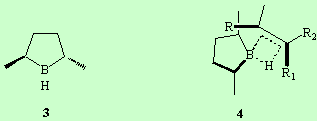
Typical % enantiomeric excesses, following oxidation, for the asymmetric hydroboration of prochiral alkenes with the reagents 1, 2 and 3 are given below.3,4,5
|
Reagent |
Type I |
Type II |
Type III |
Type IV |
|
1 |
5-30 |
60-99 |
<25 |
25-75 |
|
2 |
<5 |
<25 |
73-92 |
52-82 |
|
3 |
<5 |
95-96 |
96-99 |
93-97 |
The results would suggest Masamune’s C2 symmetric trans-2,5-dimethylborolane 3 to be the reagent of choice for asymmetric hydroboration, however, 3 has found almost no use as a reagent for asymmetric hydroboration. This is presumably because of the rather lengthy and tedious sequence of reactions and separations required for its preparation. The synthesis of 3 is outlined below. Potentially troublesome features include: preparation of the ‘double’ Grignard 5, preparation of diethylaminodichloroborane 6, the formation of approximately 50% of the unwanted cis-dimethyl borolane 7 in the cyclization step, and the subsequent need to remove this unwanted material by selective complexation.
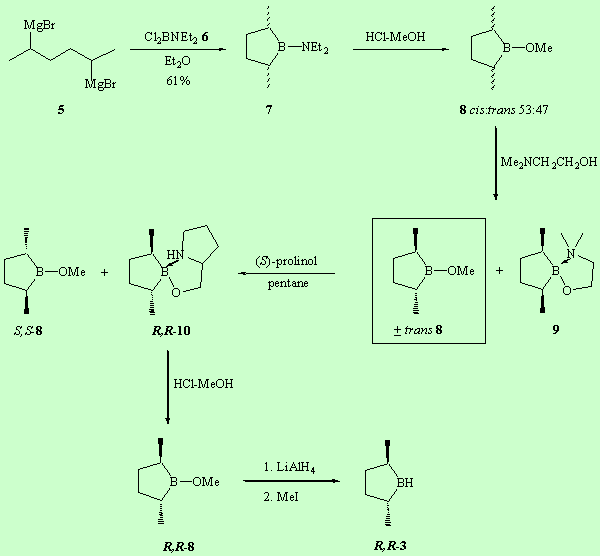
We wished to prepare new reagents for asymmetric hydroboration that retained the structural features of Masamune’s C2 symmetric trans-2,5-dimethylborolane 3 but were easier and more practical to prepare. Potentially these new reagents might give better asymmetric induction for type I alkenes as well as types II, III and IV. Trans-2,5-diisopropyllborolane 11, having a greater steric demand than its methyl predecessor, was proposed as our target. We envisioned that the trans-borolane ring system might be selectively formed via the cyclic hydroboration7 of 2,7-dimethyl-2,6-octadiene 12 and a resolution similar to that employed by Masamune would quickly give the pure enantiomers of trans-2,5-diisopropyllborolane 11.

Results
2,7-Dimethyl-2,6-octadiene 12 was conveniently prepared in large scale by two alternate methods as shown below. 4-Bromo-2-methyl-2-butene 13 was dimerized with manganese powder and iodine in refluxing THF to give a 75% yield of a 3:1 mixture of the desired 2,7-dimethyl-2,6-octadiene 12 and the isomeric 3,3,6-trimethyl-1,5-heptadiene 14. The diene 12 was isolated in pure form following careful distillation in 39% yield. Alternatively 12 was prepared via a bis-Wittig reaction. Butane-1,4-bis(triphenylphosphonium) dibromide 16 was prepared in 79% yield by refluxing 1,4-dibromobutane 15 with triphenyl phosphine. The phosphonium salt was converted to its ylide and treated with an excess of acetone to give following distillation the pure diene 12 in 54% yield.
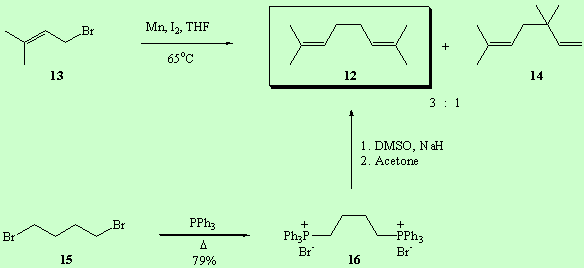
With a large quantity of 2,7-dimethyl-2,6-octadiene 12 in hand we were in position to examine its cyclic hydroboration. Still has previously reported that hydroboration of 12 with thexylborane and oxidative work up gave predominantly meso-2,7-dimethyl-3,6-octanediol.8 Repetition of this reaction and conversion of the diols to their diacetates 19 and 20 gave compounds that were easily separable by capillary column GC, which would become our method of analysis for cyclic hydroboration studies.
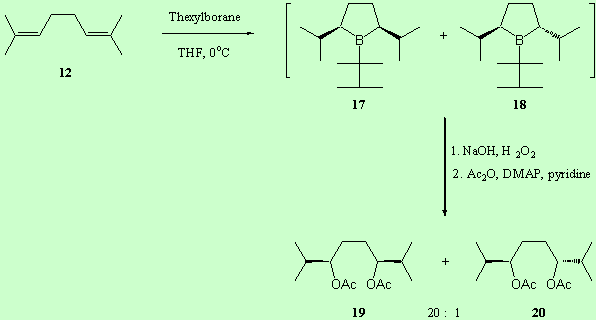
We anticipated that replacement of the bulky thexyl group of the hydroboration reagent with a smaller group would lead to greater selectivity for the desired trans-2,5-diisopropyllborolane 11. Indeed, monobromoborane gave a 2:1 ratio of the cis:trans-borolanes in THF at 0oC. Under the same conditions monochloroborane gave a 1:1 ratio and borane itself gave a ratio slightly in favor of the desired trans-borolane. The preference of cyclic hydroboration for the cis- or trans-borolane can be explained by considering the intermediates 21 and 22 in which the isopropyl group is in an equatorial position. To produce the cis-borolane 11, hydroboration must proceed across the axial double bond with the X group occupying an equatorial position as depicted in 21. To produce the trans-borolane 11 hydroboration proceeds across the equatorial double bond with the X group occupying an axial position as depicted in 22. These intermediates are consistent with the results observed. For thexylborane the large thexyl group adopts the equatorial position and therefore gives the cis-borolane 11 via intermediate 21. As the X group decreases in size (thexyl>Br>Cl>H) the intermediate 22 becomes more important and more of the trans-borolane 11 is produced under the conditions studied.
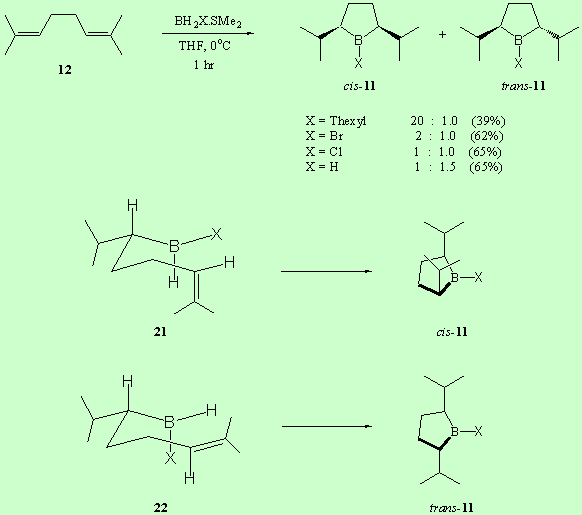
Although there is a trend towards the desired trans-borolane the ratios are not much better than those obtained by Masamune’s ‘double’ Grignard reaction in his synthesis of trans-2,5-dimethylborolane 3. Since hydroboration is a reversible reaction we postulated that under equilibration conditions the trans-borolane 11 might be the more favored product. We therefore studied the cyclic hydroboration of 12 at the refluxing temperature of several solvents with monobromo- and monochloroborane.9 The results of which are shown below.

|
Entry |
Borane |
Solvent |
Temp. (oC) |
Time (hr.) |
Yield (%) |
Trans: Cis |
|
1 |
H2BBr.SMe2 |
THF |
0 |
1 |
63 |
1.0:2 |
|
2 |
H2BBr.SMe2 |
THF |
0 |
8 |
59 |
1.0:2 |
|
3 |
H2BBr.SMe2 |
THF |
65 |
1 |
57 |
1.0:1 |
|
4 |
H2BBr.SMe2 |
THF |
65 |
8 |
55 |
1.5:1 |
|
5 |
H2BBr.SMe2 |
Et2O |
34 |
8 |
69 |
2.5:1 |
|
6 |
H2BBr.SMe2 |
CH2Cl2 |
40 |
8 |
67 |
3.0:1 |
|
7 |
H2BBr.SMe2 |
PhMe |
110 |
8 |
49 |
2.7:1 |
|
8 |
H2BBr.SMe2 |
CCl4 |
76 |
8 |
70 |
4.0:1 |
|
9 |
H2BCl.SMe2 |
THF |
65 |
8 |
62 |
1.0:2 |
|
10 |
H2BCl.SMe2 |
THF |
65 |
8 |
57 |
1.0:1 |
|
11 |
H2BCl.SMe2 |
CCl4 |
76 |
8 |
62 |
2.8:1 |
The hydroboration of 12 with monobromoborane in THF at 0oC for 1 hr gave as reported earlier a trans:cis ratio of 1:2. Increasing the reaction time to 8 hr at 0oC gave the same product ratio. However, increasing the reaction temperature to 65oC gave a 1:1 product ratio after 1 hr and after 8 hr the ratio was 1.5:1 in favor of the desired trans-borolane. Changing the solvent to ether, dichloromethane or toluene gave, after 8 hr at the refluxing temperature of the solvent, trans:cis ratios of 2.5-3.0:1. The best trans:cis ratio of 4.0:1 was found when the reaction was carried out in refluxing carbon tetrachloride for 8 hr. Similar product ratios were obtained when monochloroborane was used as the hydroboration reagent. Frustratingly, increasing the reaction times further or carrying out the reaction in sealed tubes at higher temperatures failed to improve the trans:cis ratios and generally resulted in extensive decomposition of the products. Nevertheless the trans:cis ratio of 4:1 from the carbon tetrachloride reaction was a significant improvement and we next investigated the resolution of the borolane isomers.
In Masamune’s work the cis-dimethylborolane was removed by complexation with N,N-dimethylaminoethanol and the trans-dimethylborolanes 8 then resolved by complexation with (S)-prolinol and (S)-valinol respectively. Initially we tried to directly resolve our 4 : 1 mixture by complexation with the appropriate amount of (S)-prolinol, however, the small amount of complex formed was identified as the cis-borolane complex. Attempted resolution with various other amino alcohols also failed to precipitate the trans-borolane. It therefore appears to be necessary to remove the offending 20% of the cis-borolane 24 first. Replication of Masamune’s work with N,N-dimethylaminoethanol failed to produce a separable complex. Various primary, secondary and tertiary amino-alcohols were screened in the complexation process. Gratifyingly the use of pyrrolidinoethanol in hexane at low temperatures gave a precipitate of the cis-complex 25. Storage of the mixture at –78 oC for 4 hr and removal of the solution via cannula left behind essentially pure cis-complex 25. The decanted solution was concentrated and distilled at reduced pressure to give the racemic trans-borolane 23 in >95% purity and 63% yield.
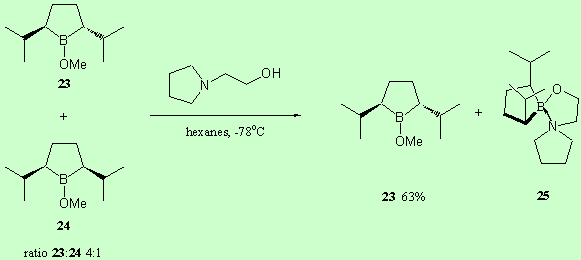
Conclusion
Pure racemic trans-2,5-diisopropyl borolane 23 was isolated following cyclic hydroboration of the readily available diene 12 and selective complexation of the cis-2,5-diisopropylborolane 24 with 1-(2-hydroxyethyl)-pyrrolidine. The resolution of 23 and application of the derived chiral borolanes in asymmetric synthesis will be described in due course.
Acknowledgments
KJH wishes to thank University College Dublin and Schering Plough (Avondale) for the funding of this research under the Newman Fellowship program and the Department of Chemistry at the University College Dublin for the use of facilities during this research. GL and MZ wish to thank University College Dublin under the erasmus student exchange program. Dr Mike Casey is warmly thanked for his disclosure of unpublished results and his help throughout the course of this work.
References and notes


All comments on this poster should be sent by e-mail to (mailto:[email protected]) [email protected] with A0094 as the message subject of your e-mail.